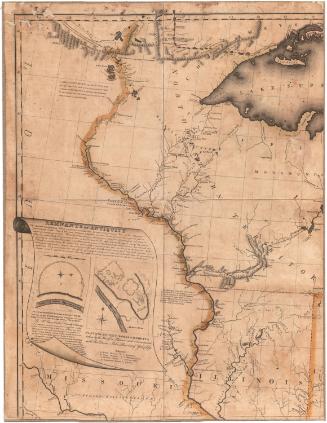"Proprietor's Map" of a portion of the town of Windsor, Connecticut lying east of the "Great River" and within the present bounds of Ellington, Connecticut as the land was originally laid out during the period 1728 - 1752
DraftsmanDrawn by
Alfred E. Schindler
(American, born 1931)
DraftsmanDrawn by
Mark O. Hoffman
(American, born 1949)
MakerBased on research by
Dorothy B. Cohen
(American, 1917 - 2005)
Date1985
MediumLithography; brown ink on wove paper
DimensionsPrimary Dimensions (image height x width): 35 3/8 x 63 5/8in. (89.9 x 161.6cm)
Sheet (height x width): 36 1/2 x 65in. (92.7 x 165.1cm)
ClassificationsGraphics
Credit LineGift of Dorothy B. Cohen and Alfred E. Schindler
Object number1985.238.0
DescriptionLand ownership map of what was then part of Windsor, Connecticut, now known as Ellington, extending from the borders of Enfield, Somers and Stafford to the north, Willington to the east, South Windsor, Vernon and Tolland to the south, and East Windsor to the west. Plots of land are labeled with their number, their acreage and the owner's name. Divisions, called "Windsor Commons," "Mile-and-Half-Mile," "Sequestered Land" and "Equivolent," are labeled on the map, along with "tears," or divisions of 317 lots in one half-mile wide increments, separated by highway allowances. Roman numerals are used to identify the various land grantees.
Around the map, there are vignettes depicting animals, Native Americans, various dwellings, farming scenes, meetings and land surveying. A section located below the map, titled "General Notes, Background and Legend," provides information about Ellington's growth, the divisions of land, land grants, and the various grantees. The legend shows the lines that denote brooks, present highways, township lines, parish lines and fenced-in grant lands, as well as the symbols that represent parsonage sites, burial sites, saw-grist mills and schools. The cartouche shows three seals, those of Windsor, East Windsor and Ellington; two vignettes depicting discovery; a rifle; and a vignette showing men working to raise a house while Native Americans look on.
Around the map, there are vignettes depicting animals, Native Americans, various dwellings, farming scenes, meetings and land surveying. A section located below the map, titled "General Notes, Background and Legend," provides information about Ellington's growth, the divisions of land, land grants, and the various grantees. The legend shows the lines that denote brooks, present highways, township lines, parish lines and fenced-in grant lands, as well as the symbols that represent parsonage sites, burial sites, saw-grist mills and schools. The cartouche shows three seals, those of Windsor, East Windsor and Ellington; two vignettes depicting discovery; a rifle; and a vignette showing men working to raise a house while Native Americans look on.
Label TextLike so many Connecticut towns, Ellington was created by subdividing another, larger town, in this case the town of Windsor. One of Connecticut's first three towns, Windsor is located on the west side of the Connecticut River (or "Great River" as it is called on this map), but during the seventeenth century the town acquired vast tracts on the east side of the river as well. A portion of these lands known as the "Great Swamp" became the town of Ellington in 1735. The "Proprietors" from whom the map takes its name, were the original settlers of Windsor, whose descendants were allotted property in the area included in the map during subsequent land divisions.
Dorothy B. Cohen, the town historian of Ellington, created this map in 1985 with the aid of two local surveyors, Alfred E. Schindler and Mark O. Hoffman. Their map reflects the self-conscious pride of a small Connecticut town in its historic origins.
NotesCartographic Note: Scale: 1 inch equals 3000 feetDorothy B. Cohen, the town historian of Ellington, created this map in 1985 with the aid of two local surveyors, Alfred E. Schindler and Mark O. Hoffman. Their map reflects the self-conscious pride of a small Connecticut town in its historic origins.
Status
Not on view










